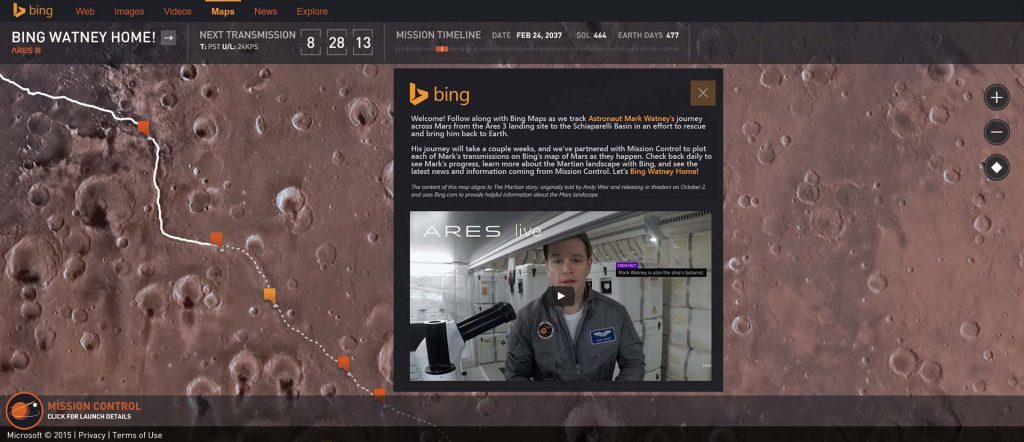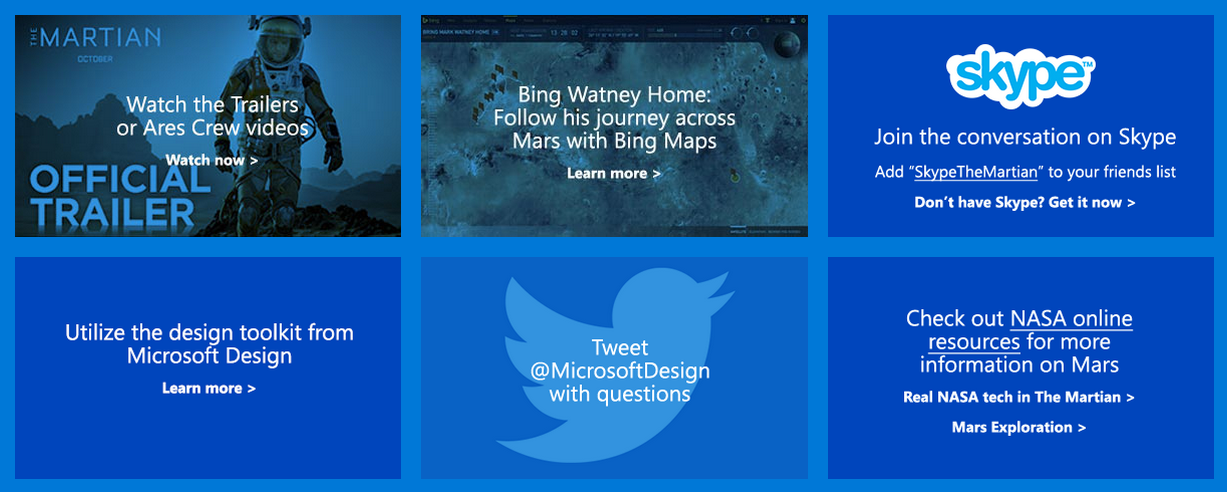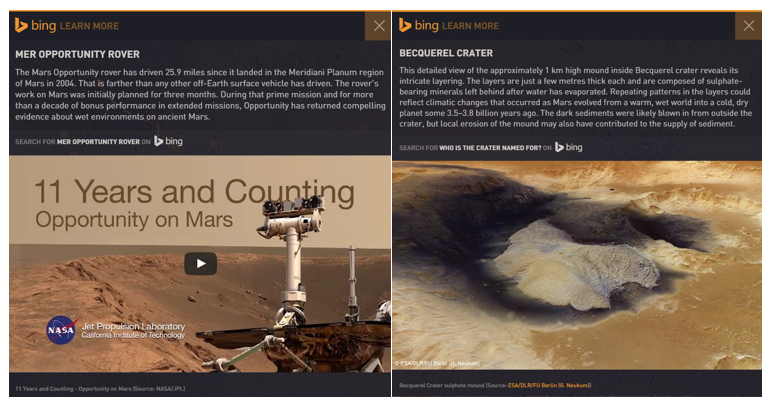
Microsoft brings ‘The Martian’ to Earth with Hacking Mars design challenge, Bing Watney Home map experience and more
Hang in there, Mark Watney. The world is cheering for you to find a way home. Everyone’s watching every move you make, every arduous step you take, every wry observation.
This particular castaway is an astronaut stranded alone on Mars, forced to survive with extremely limited resources, in a place completely inhospitable to human life. But this futuristic MacGyver – Andy Weir’s protagonist from “The Martian” – is determined to contact NASA and get back to his family.
Here on Earth, starting Sept. 15, teams will compete in a Hacking Mars design challenge to come up with solutions to help Watney, while fans can track his progress on the Red Planet with a new interactive map from Bing. And teachers and students across the country will be able to download space-related curriculum through Bing in the Classroom .
These are just some of the ways that Microsoft has partnered with 20th Century Fox to tap into the release of the film adaptation of “The Martian” as an opportunity for fans of all ages to learn more about Mars and space. It’s also a way to empower those around the world to embrace and imagine what life on Mars could look like.
“20th Century Fox is excited to partner with Microsoft on an epic partnership for our epic film, ‘The Martian.’ To see how Microsoft has brought the ideas and values of the film alive across Bing, Skype, and so much more is impressive and thrilling,” said Zachary Eller, senior vice president, Marketing Partnerships, 20th Century Fox. “The detail and effort that went into pulling this program together is truly monumental. We couldn’t be happier with the results, and we know moviegoers will want to engage in the amazing content and activation that Microsoft has created.”
The Hacking Mars Design Challenge invites teams to research and submit a three-to-five minute video about a product, service, app or game that would help Watney: stay alive (grow food, filter air, produce water), pass time (keeping hope alive, dealing with extreme isolation and constant stress) and get home (focusing on communication issues). They can tackle one topic or take on all three. The deadline for entries is Oct. 13.
The challenge website provides steps, instructions, a toolkit and other resources for the challenge. Participants will be able to tap into Microsoft experts via Skype and watch videos related to the film. Another big bonus: custom-made videos from Fox containing interviews with the novel’s author, Andy Weir, talking about the challenges Watney faces on Mars as they relate to those three topics.

“While reading the book we could see a lot of similarities to the work that happens across Microsoft. We often use films, especially science fiction, as inspiration for our products. What we loved about The Martian is how human it is. Technology is hacked in extreme ways to benefit the thing that matters most – the person in need. It shows how design can start with the most basic human needs, like food, entertainment, and a sense of connection. If we design with these basics in mind, we end up creating solutions that benefit people on a universal scale,” says Sarah Morris, a senior design strategist in the Windows and Devices design team. “Our idea was simple: designing a solution for Mark Watney on Mars can also lead to designing better solutions for people on Earth. Together, with Jen Buckmaster in marketing, we called the filmmakers to see if they wanted to partner.”
Out of three groups of finalists, one team will emerge victorious and travel to Microsoft to experience HoloLens and pocket a $25,000 grand prize for #HackMars – in addition to a suite of Microsoft products like Surface, Xbox One and Microsoft Band. Though anyone in the world over the age of 18 can enter the competition, students with STEAM (science, technology, engineering, the arts and math) backgrounds and interests are strongly encouraged to try it out, as the film tie-in presents such a strong educational opportunity.
“We’re giving students about one month. It’s a short time frame – a tie-in to the urgency Mark Watney faces as he has a very short time frame before he runs out of resources,” Morris adds. “We’re asking them to form teams – up to three people, and partner with friends in different areas of study. So if you’re a designer, grab a friend who’s majoring in computer science or physics, for instance. We’re asking them to put the human first, not the technology. Put the person at the center, understanding his environment, his problems. And then as they journey through the design process, we ask them to interview people who might be facing similar constraints, mismatches between their environment and their body, here on Earth. We challenge them to think about what solutions they might build for this person that could be more broadly applicable, like creating a communication solution for Watney, who only has a camera, with no audio, to communicate. This solution might also be applicable to people who experience hearing loss here on Earth.”
Leading up to the Oct. 2 broad release of “The Martian” movie, fans can also follow along via an interactive experience that takes you along the same path Watney took from Ares 3 to Ares 4 (the landing sites of the NASA Mars landings in “The Martian”). The experience uses real imagery of the Red Planet, Bing Maps API and the Azure platform to track Watney’s journey across Mars. Across the map, fans will find points of interest that include videos, search results and other resources that add more context for curious would-be space travelers. In addition, Watney will be sending transmissions of his progress every day from Sep. 15 until he reaches his destination in early October. Fans of the book will recognize “Bing Watney Home” as a tongue-in-cheek reference to the worldwide mantra that unites people who supported the mission and its resourceful hero as he fights to get home.
“Fans of ‘The Martian’ are going to love this. In the book, the entire Earth rallies around bringing Watney home. When we had the chance to partner with Fox, building a map immediately came to mind,” says Bryan Saftler, a senior marketing manager for Bing. “As a search engine, Bing seeks to connect the knowledge from the Web to the things you do every day. In our map, we look for ways to provide you additional context that can help you better understand what you’re looking at. This was a perfect opportunity to use our technology to tell a really cool story.”
While the book – especially Watney’s journal entries – is very descriptive and engaging, there are few visual illustrations. But with the Bing mapping experience, fans will be able explore his expedition at their own pace. They’ll be able to zoom in and out to view the landscape and “The Martian” content, hover over flags and markers to see a sneak peek of information such as coordinates and relevant topics.
“They can see the story through a new lens,” Saftler says. “It’s a great opportunity to understand how dangerous and difficult his journey was.”
Another educational aspect of Fox and Microsoft teaming up for “The Martian” is the opportunity for classrooms to participate in discussions about space through lesson plans about science, engineering and language arts, all available to K-12 educators.
“The concept of traveling to another planet is still new and foreign, and can be intimidating,” says Bonnie McCracken, a senior product marketing manager for Bing. “These lesson plans help them interact and be entertained at the same time. It’s a really great way to connect with the story while also learning.”
The Bing home page lesson plans coincide with home page images that teachers of different grade levels can use for free. They can incorporate the plans into daily routine, or use them at various points during the school year.
“The Martian” could also stir interest in STEAM classes, and that’s an area in which Microsoft has made significant investments through Microsoft YouthSpark, a global initiative to provide access to computer science education to all youth. Educators, engineers, software developers or programmers interested in helping high school students learn computer science can volunteer through TEALS (Technology Education and Literacy in Schools), a cornerstone of YouthSpark. Microsoft YouthSpark also encourages coding and problem solving at an early age through the YouthSpark Summer Camps, Microsoft Imagine and its global support to the Hour of Code.
Who knows, maybe amidst these budding technologists, a real Mark Watney will emerge.
Lead image: Bing Watney Home experience

















